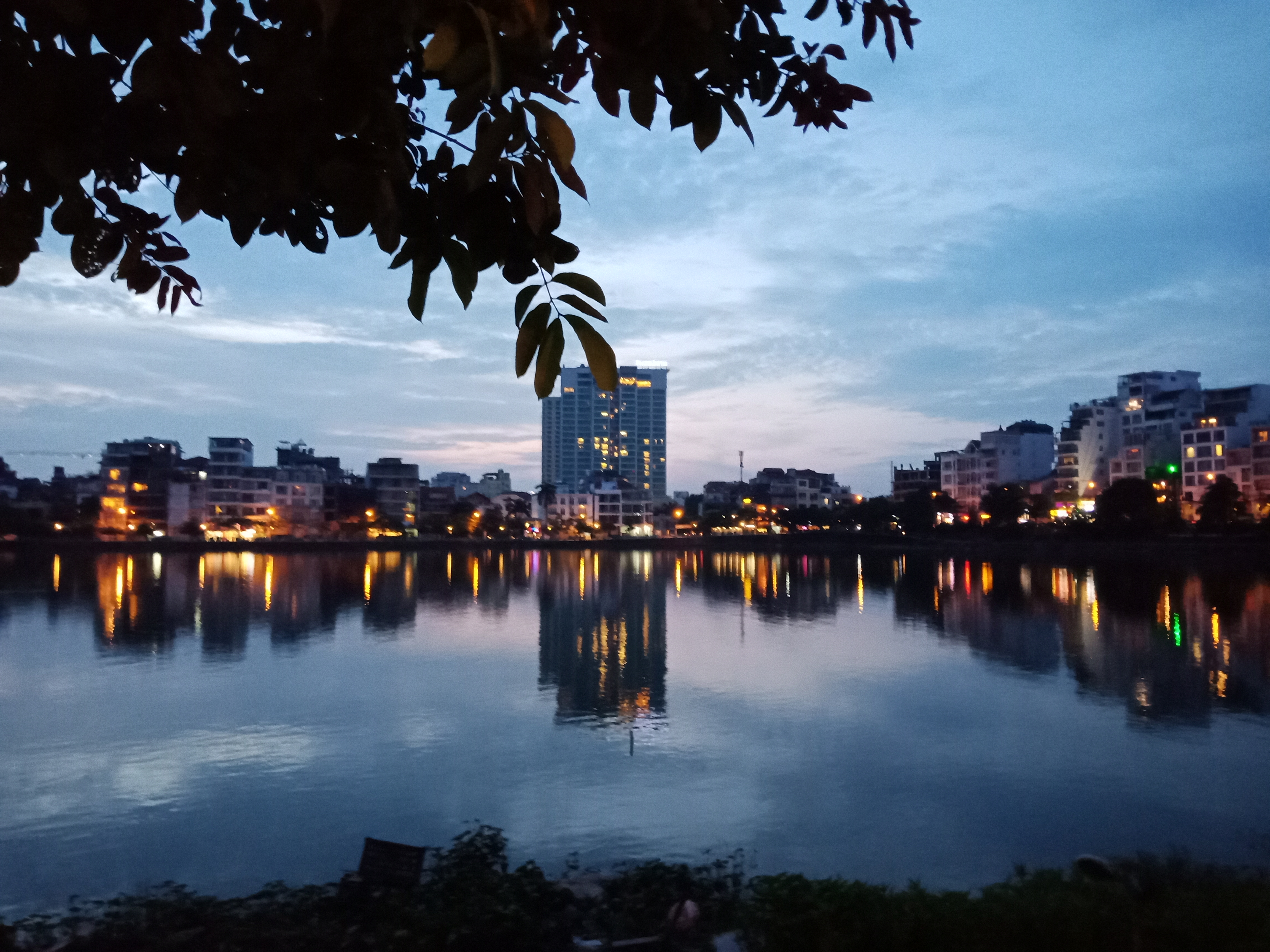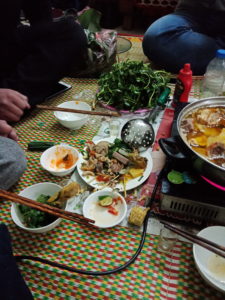
Where is the first place to go when you visit Hanoi?
Almost everyone stays in the Old Quarter, the ancient, alternate-dimension Temple Bar of Hanoi. And almost every visitor is met at their accommodation and lazily taken for a token tour of its narrow, claustrophobic, traffic-saturated streets, to marvel at the blur of human activity, before completing a lap of the famous Hồ Hoàn Kiếm (Sword Lake) at the southern edge of the maze. It’s a good introduction but it’s exactly what you’d end up doing even if you didn’t have a local guide.
So I like to take people to the Ba Đình district on the western edge of the city centre to get a less-touristy and more real sense of the chaos that is Hanoi. There you’ll find densely packed neighbourhoods and communities, many of whose residents might rarely or never venture more than a few blocks away from where they were born. There are restaurants and vendors offering street-specific local food specialities, endless shapes and sizes of cafés offering the delicious local cà phê sữa đá (iced coffee with condensed milk), and the feeling of being an overwhelmed and lost alien which often comes with living in Vietnam as a foreigner. It’s also where many of the historic government buildings are located, in beautifully preserved colonial-era buildings in the city’s distinctive ochre colour.

[People watching is one of the best ways to kill a couple of hours in Hanoi. Here some men get to work in the crowded Yên Hoà neighbourhood, Cầu Giấy district, Hanoi.]
The top three things to do there, that don’t cost a lot of money, are…
People watching. Hanoi has neither an Eiffel tower nor an Empire State Building to gawk at and take pictures of. The city’s greatest sights are the never-ending streams of people going about their everyday lives. People working, walking, delivering, riding scooters, making food, going to school, eating, drinking, chatting, interacting, arguing, haggling, laughing, playing. Walk around or take a seat and drink in the humanity. And, of course, you mightn’t have ever before seen a young boy doing his homework on the back of a scooter at 30kph, who doesn’t glance twice when they’re overtaken by another man with a cow on the back of his bike.
Cycling around West Lake. The intensity of the city centre is intriguing, but a break is welcome. Take a leisurely cycle around the 16km circumference of West Lake, just north of the city centre. It’s surrounded by cafes, bars and street-side tea stalls, many of which thoughtfully provide sun loungers or bamboo mats laid on the ground. The north-eastern side is a beautiful spot for a sunset, best enjoyed with a refreshing, and fresh, coconut.
Banana Island. A hidden jungle on an island under the Long Bien Bridge, surrounded by the murky waters of the Red River. Inhabited by banana farmers who sell their produce to the city markets, it’s one of those “I can’t believe I’m still in the same place” kind of places. A rough grid of dirt trails run the length and narrow breadth of the island, which can be reached by a precarious off-shoot from the rusty old-timey bridge, which looks like its lifted from the dark room of a 19th century photographer and gives its surroundings a sepia tinge no matter what time of day or year you’re looking at it.
Where is the best place to get a sense of Hanoi’s place in history?
People ask the very good question of whether the Vietnamese tend to hold a grudge against foreigners, specifically Americans.
The answer is “No” – they’d just rather talk about something other than war and politics. Vietnam has its own culture and history which its people are much keener to promote and discuss these days, and besides, those sides of history aren’t very prominent in Hanoi. They’re better studied elsewhere in the country.
One unique feature of Hanoi’s thousand-year past (it recently celebrated its millennial anniversary having been founded in 1010) is its street-specific shopping system.
The roughly 36 streets of the Old Quarter bear the names of the merchant classes who used to inhabit them exclusively. The word ‘hàng’ is common to many of them – meaning ‘shop’ or ‘merchant’. There are still streets bearing the names of traditional silver merchants (Hàng Bạc), the iconic traditional conical hats worn to protect from the overbearingly hot Vietnamese sun (Hàng Nón), and if you’re looking for that ‘acquired’ taste of Vietnamese cooking, try Hàng Mắm for all your fish sauce needs.
How to eat in Hanoi
Vietnamese cuisine has become a big deal in recent years, though I’m loathe to pay €12 for a bowl of phở back in Ireland, even if it reminds me of ‘home’.
Similar to the way particular goods have taken up traditional residences in particular streets over the years, the most abundant and best examples of certain dishes are found on certain streets.
Go to Nguyễn Hữu Huân for delicious xôi xéo sticky rice, the city’s favourite cheap morning snack.
Lý Văn Phức near Hanoi Football Stadium is the glorious home of barbeque chicken, popular with locals and ex-pats alike. The first restaurant on your left (it’s a cul de sac) offers generously meaty wings, breasts and thighs. Ask for the delectable honey bread to go with it. It’s super cheap also.
Find the relatively secluded Green Lake area at Ngõ 135 Đội Cấn for a choice of street vendors serving the wonderful pairing of nem lụi huế and bánh xèo – pork-meat-on-a-lemongrass-skewer and delicious crispy pancakes made with shrimp and veggies, all served in rice paper rolls. Bring a group, pull up some stools, and keep shouting at the lady for more until you’ve had your fill.
Shouting “ơi!“(“hey!”) to get someone’s attention is a local and in no-ways rude local custom which, even after several years living here, those with Western sensitivities to noise and personal space are still too timid to get fully right. The locals have a knack of communicating with laser precision through hives of noise to just the person whose attention they were trying to get. And get a beer.
Finally, skip phở and get your noodle fix with some bún bò nam bộ at 67 Hàng Điếu. The best version I’ve tasted of my favourite Vietnamese dish.
Although Vietnamese cuisine has become popular worldwide in recent years, I’m still a bigger a fan of Vietnamese cooking as found in the bia hoi , the ever-present traditional beer halls of Hanoi named for the ‘fresh beer’ they serve, along with group-sized plates of simple but delicious meat, rice and vegetables.
The Vietnamese are masters in home-style cooking using minimal ingredients. Enjoy beef, buffalo and pork served with aromatic dipping sauces and veggies like morning glory.
Be prepared to be offered rượu (rice wine – theoretically Vietnamese variant of sake but often more resembling poitín in its production origins and potency) at any time of the day or night by locals amused and delighted by your presence. It’s rude to say no.

[Home cooking is best in Vietnam. Simple food, fresh ingredients, done right.]
Best souvenirs to take home?
Coffee. Vietnam is the world’s second-largest producer of coffee. It can be enjoyed black or ‘brown’; warm or over ice; it’s best served mixed with condensed milk, over ice. Be careful though, while it’s got the luxurious texture and flavour of a White Russian, it’s got the caffeine-times-sugar hit of two Red Bulls. Enjoy one, don’t drink two.
The Vietnamese are actually a bit more creative with their coffee than Westerners. Rather than trying to figure out different ways to add milk to coffee, cafes add egg, yoghurt, coconut and other different surprises to really try and liven things up a bit.
Visit Café Giang on Nguyen Huu Huan, or Café Dinh at the top of Hoan Kiem Lake to see who makes the better egg coffee: the son or the daughter, respectively, of the guy who invented it run these places, and they’re within walking distance from one another.
One of the best creations however is coconut coffee, and most locals will admit that the Công Caphé chain is the king of it. I’ve met more than one person who’s told me they’ve returned to Vietnam just to try another one of these, and whether or not that’s true they’re worth the hyperbole.
The recipe is coffee, ice cream and coconut, and although Cong Caphé is the best one, they’re usually available in any mid-size town in Vietnam i.e. they’re not just for tourists, and even if you get lost in a place where foreigners don’t usually wander, you can find comfort in a cà phê cốt dừa.
Take home the recipe for a coconut coffee and you’ll be the boss of non-alcoholic parties.